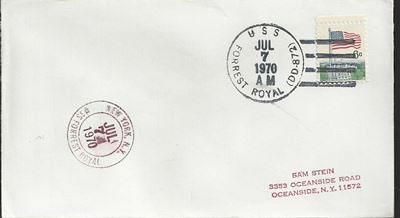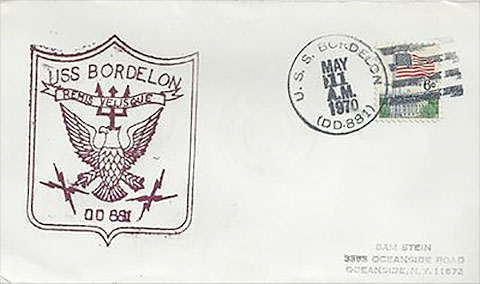Space Cover 623: Apollo 13 Emergency Recovery ShipsDuring the Project Mercury orbital missions nearly twenty-five recovery ships were assigned to the flight for recovery operations. With the increasing accuracy of the splashdown trajectories the number of ships and planned recovery sites dramatically reduced to really two situations – ships in the Atlantic near Kennedy Space Center in the case of a launch abort (typically salvage type ships) and in the single planned splashdown area.
For the Apollo 13 launch, fleet ocean tug USS Paiute, and salvage ship USS Escape were positioned near Kennedy Space Center. Also in the Atlantic Ocean was the destroyer USS New.
"On paper" there were four possible recovery sites for the splashdown at the end of an Apollo mission in what the US Navy Recovery Officers referred to the Mid-Pacific Line, the West-Pacific Line, the Atlantic Ocean Line, and the Indian Ocean Line.
For Apollo 13, all four of these recovery sites still existed in the minds of the Recovery Officers, but only one of them, the Mid-Pacific Line, had any ships at it. The assigned ships in the Mid-Pacific Line were the primary recovery ship USS Iwo Jima and secondary recovery ships supporting the USS Iwo Jima – the guided missile destroyer USS Benjamin Stoddert and the oiler USS Kawishiwi.
After the Apollo 13 explosion and mission abort, the Recovery Officers were told that they might have to have a rescue force at any one of seven places within as little as thirty-six hours.
First, the Recovery Officers called the Department of Defense to see if any United States Navy recovery ships happened to be near any of the targets; they also surveyed "non-dedicated" Navy ships and merchant shipping around the world for what they called "ships of opportunity" to help in the recovery effort.
From the NASA Apollo 13 Mission Report "Because of the emergency which resulted in premature termination of the mission, additional support was provided by the Department of Defense and offers of assistance were made by many foreign nations, including England, France, Greece, Spain, Germany, Uruguay, Brazil, Kenya, the Netherlands, Nationalist China, and the Soviet Union. As a result of this voluntary support, a total of 21 ships and 17 aircraft were available for supporting an Indian Ocean landing, and 51 ships and 21 aircraft for an Atlantic Ocean landing. In the Pacific Ocean, there were 13 ships and 17 aircraft known to be available over and above the forces designated for primary recovery support." There is no published list of all the additional ships and aircraft called into action due to the emergency. It is highly likely that many of these ships and aircraft would have been placed on standby for the recovery effort.
The nearest "ship of opportunity" to the Atlantic Ocean Line turned out to be the carrier USS America, which had just left Puerto Rico but the USS America would not be able to arrive at the splashdown site until twenty-four hours after a splashdown there.
The USS Granville S Hall was dispatched to join the support group of the USS Iwo Jima. Two other US Navy ships, the USS Forrest Royal and the USS William C. Lawe are known to have been activated to support the recovery effort but their position in the Pacific Ocean is unknown.
Four ships of the British Far East Fleet steamed to a recovery area – these included HMS Nubian, HMS Phoebe, RFA Tarbatness, and the RFA Tideflow. In addition, three German freighters were in the area and offered to assist if needed – they were the MS Cap Blanco, MS Cap Vilano, and the Libanon.
Initially Apollo 13 was targeting a splashdown in the Indian Ocean. The initial rocket firing to head back to Earth took place five and a half hours after the explosion and a planned minor correction later would aim the craft into a narrow corridor through the earth's atmosphere which would bring the astronauts, in less than four days' time, to the Indian Ocean. The Recovery Officers had never stationed a ship in the Indian Ocean. The nearest US Navy ship was the destroyer USS Bordelon, which was off the coast of Mauritius. Luckily, the USS Bordelon was one of several Navy ships that had been modified to take a special crane for picking command modules out of the sea. However, the Recovery Officers would have to order the crane flown from Norfolk, Virginia, to Mauritius. They were banking on the fact that the USS Bordelon would get to port, pick up the crane, and be at the splashdown site, seven hundred miles away, before the astronauts could get there.

After the initial trajectory was taking the spacecraft to the Indian Ocean, the NASA team evaluated multiple alternatives to return the astronauts to Earth safely. After performing multiple simulations the decision was made to bring the astronauts back to the original splashdown point which was the only location with full recovery capabilities. And, as we know, the splashdown and recovery was successful.
Long-time space collector Sam Stein is the recipient of the pictured covers from the USS Bordelon and the USS Forrest Royal. As Sam had very few ship cancels in his collection other than space recovery ships it seems likely that Sam, at some point in time, received information that the two ships participated in the Apollo 13 recovery and sent covers off to be cancelled to record their participation even if it was after the actual event. These late dates are the closest I have seen to their actual role in the recovery effort for any of the emergency recovery ships.













